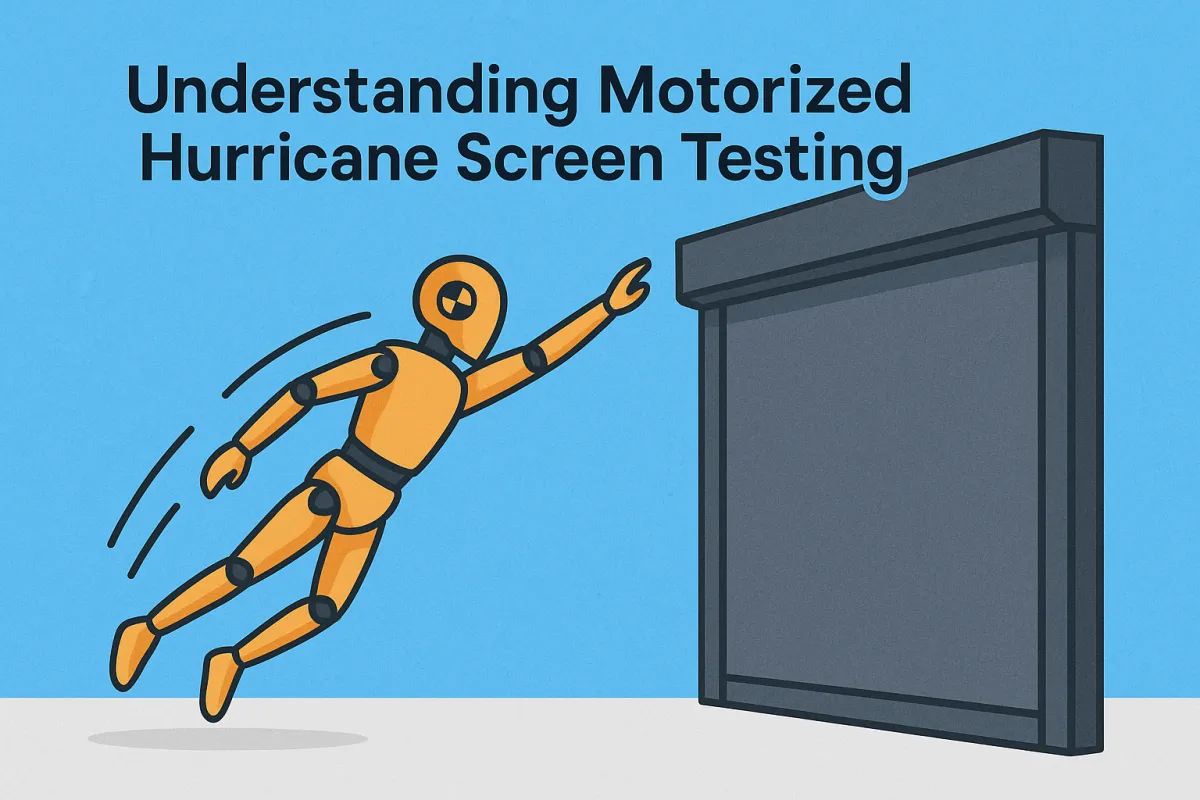
The Crash Test Dummy for Motorized Hurricane Screens
Why Hurricane Screens Need Testing (And Why You Should Care)
Imagine This...
You wouldn’t buy a car that hadn’t been crash-tested, would you? Imagine driving off the lot with something that looks good on the outside but hasn’t proven it can keep you safe when things go wrong. There’s no data. No real proof. Just a shiny body and a promise.
Now think about your lanai, your patio, or the screened enclosure over your pool. These are the parts of your home that take the brunt of every storm. And yet, many people install motorized “hurricane” screens without ever asking if those screens have been tested to survive what Florida weather can really throw at them. Bottomline: Not all Motorized Hurricane Screens are Created Equal
So, What Does Testing Even Mean?
When we talk about testing hurricane screens, we’re not just referring to how well they stay in place on a sunny day. We’re talking about full-scale, lab-controlled trials that simulate the real conditions of a major storm. That means launching 2x4 boards like missiles at high speeds to see if the screen can withstand impact. It means applying hurricane-force wind pressure — not just from one direction, but both in and out — to replicate the push and pull of a storm. And it means repeating those pressure cycles over and over, because hurricanes don’t just hit once and leave. They gust, shift, and roar for hours.
What If The Motorized Hurricane Screen Is Not Tested?
Imagine it like this: if your motorized screen were a soldier, this kind of testing would be its boot camp. Only the toughest, best-built screens make it through. The rest? They fail. And in real life, failure doesn’t just mean a broken screen — it can mean water damage, blown-out enclosures, and dangerous debris entering your home.
Don’t Trust the Label On The Motorized Hurricane Screens.
Unfortunately, not every company tests their products to these standards. Some will slap on labels like “hurricane-rated” or “storm-tough” without ever submitting their screens to true impact or wind-load testing. That’s like calling a rain jacket waterproof just because it looks like one. As a homeowner, this is where you need to get smart. Don’t trust the label.
Ask For The Proof of Certification.
Look for certification against established testing standards — names like ASTM E330 (which checks how well the screen can handle static wind loads), ASTM E1886 and E1996 (which simulate both impact and wind pressure over time), and TAS 201, 202, and 203, which are the gold standards in hurricane-prone areas like Miami-Dade and coastal Florida. If a manufacturer or installer can’t provide documentation showing their product passed these tests, it’s time to walk away.
What Testing and Certification to look for when it comes to motorized screens...
The good news is, tested and certified screens exist — and they’re engineered for exactly the conditions we face here in Florida. Look for screens built from aircraft-grade aluminum like 6063-T6, with tensioning systems that self-correct (so the fabric doesn’t jam or tear under pressure), and motor housings rated to handle wind and water. Two of the most trusted options in the Florida market are the MagnaTrack Defender Motorized Hurricane System from Progressive Screens and MaxForce Motorized Screen Systems by Fenetex Motorized Screens — products that’s been independently lab-tested and designed to take a beating and keep functioning. Most importantly, both possess Florida Product Approval Codes.
Final Thoughts...
At the end of the day, it’s simple. Your motorized screen system is more than a sunshade. When a hurricane comes, it becomes part of your home’s defense system. You wouldn’t trust a parachute that hadn’t been tested. Don’t trust a screen that hasn’t either. Because when the storm hits, you don’t want pretty — you want proven.
Brought You By...

Sources:
ASTM E1886 – Standard Test Method for Impact Resistance
🔗 https://www.astm.org/e1886-23.html
ASTM E1996 – Standard Specification for Performance of Exterior Windows, Curtain Walls, Doors, and Impact Protective Systems
🔗 https://www.astm.org/e1996-23.html
ASTM E330 – Structural Performance of Exterior Windows, Doors, Skylights Under Static Air Pressure
🔗 https://www.astm.org/e330-e330m-14.html
Florida Product Approval System
(Used to verify hurricane-rated products in Florida)
🔗 https://www.floridabuilding.org/pr/pr_app_srch.aspx
Miami-Dade Notice of Acceptance (NOA) Search
(Confirms products tested to TAS 201, 202, 203)
🔗 https://www.miamidade.gov/building/pc-search_app.asp
TAS 201, 202, 203 – Testing Application Standards for Impact, Air Pressure, and Cyclic Wind Pressure
(Miami-Dade County specific; included in Florida Building Code HVHZ)
🔗 https://www.miamidade.gov/building/library/testing-application-standards.pdf
